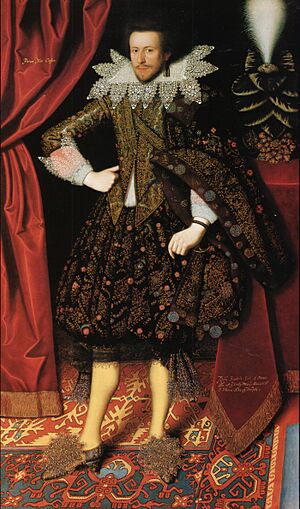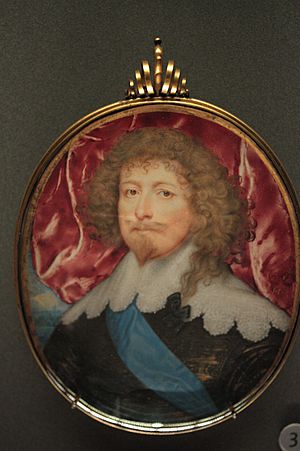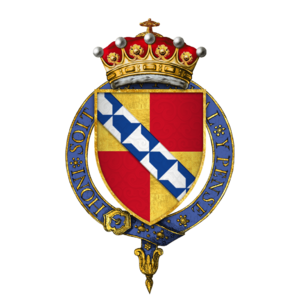Edward Sackville, 4th Earl of Dorset facts for kids
Edward Sackville, 4th Earl of Dorset (born in 1591, died on 17 July 1652) was an important English nobleman, soldier, and politician. He was a member of the Order of the Garter, a special group of knights. He served in the House of Commons, which is like a parliament, from 1621 to 1622. In 1624, he became the Earl of Dorset. Early in his life, he was involved in a famous disagreement. He also helped with the first English settlements in North America. During the English Civil War, he supported the King's side, known as the Royalists.
Contents
Early Life and a Famous Duel
Edward Sackville was the younger son of Robert Sackville, 2nd Earl of Dorset. His mother was Margaret, a daughter of the Duke of Norfolk. He studied at Christ Church, Oxford, and later at Cambridge University.
In August 1613, Edward Sackville became well-known because of a duel he fought. A duel was a formal fight between two people, usually with swords, to settle a disagreement. Edward Sackville fought against Edward Bruce, 2nd Lord Kinloss. This duel was about a famous lady named Venetia Stanley. The fight happened in the Netherlands. Edward Sackville was badly hurt but managed to win the duel. He survived his injuries and later explained his side of the story. Venetia Stanley later married Sir Kenelm Digby.
Starting a Career in Politics and Colonization
Some records suggest that Edward Sackville was elected as a Member of Parliament (MP) for Sussex in 1614. In 1616, he helped release Sir Edward Herbert from arrest in France. He was made a Knight of the Bath in 1616 when Charles I became Prince of Wales.
From 1619, he was a key member of the Virginia Company. This company was involved in setting up English colonies in North America. In 1620, he sailed as a commander with forces sent to help Frederick V, who was the King of Bohemia and the son-in-law of King James I. He was present at the Battle of White Mountain.
In 1621, Sackville was again elected as an MP for Sussex. He spoke in Parliament to support Francis Bacon, a famous statesman. In July 1621, he briefly served as an ambassador to Louis XIII of France. He strongly supported giving money to help get back the Palatinate, saying it was important for religion.
He was also the governor of the Bermuda Islands Company in 1623. In 1624, while traveling in Europe, he received news that his older brother, Richard Sackville, 3rd Earl of Dorset, had died. This meant Edward Sackville became the fourth Earl of Dorset.
Becoming the Earl of Dorset
When Edward Sackville became the Earl of Dorset, he inherited family lands. However, there were many debts from his brother, and he had to sell some land to pay them off.
He took on several important roles. He became a joint Lord Lieutenant of Sussex and Lord Lieutenant of Middlesex. These roles meant he was the King's representative in those areas. He was also made a Knight of the Garter in 1625. At the coronation of King Charles I in 1626, he carried the first sword. He also joined the Privy Council, a group of advisors to the King.
His influence at court grew when he was appointed Lord Chamberlain to Queen Henrietta Maria in 1628. As Lord Chamberlain, he played a big part in London's theatre and drama scene. He helped establish the Salisbury Court Theatre. He continued his involvement with American colonization, serving as a commissioner for planting Virginia in 1631 and 1634.
As a peer and a member of the Privy Council, Dorset was very active. He was involved in managing new buildings in London and Westminster. He was also a commissioner for the navy and for improving the supply of saltpetre, which was used to make gunpowder. In 1636, he was the constable of Beaumaris Castle.
He kept his connection with America, asking for land on Sandy Hook Island in 1638. In 1640, he was one of the noblemen chosen to act as regents when the King was away. He helped arrange the marriage of Princess Mary to the Prince of Orange in 1641. He also tried to stop a mob from intimidating Parliament in 1641.
During the English Civil War
In early 1642, Edward Sackville joined King Charles I in York. He promised to support the King with a troop of sixty horsemen. He was with the King when the English Civil War officially began.
During the war, his home, Knole House, was plundered by parliamentary soldiers. He was present at the Battle of Edgehill, an important early battle. He went to Oxford with the King and often spoke out against continuing the war, wishing for peace.
He held several important positions for the King during the war, including Lord Chamberlain of the household. He was also in charge of the privy seal and led the King's council. He made speeches that showed his desire for peace and his loyalty to the King. He was one of the people who signed the surrender of Oxford in 1646.
After the war, Dorset had to pay a fine for supporting the King. He was assessed at £5,000, but this was later reduced.
After the King was executed in 1649, Edward Sackville is said to have stayed mostly at his home in London. He passed away there on 17 July 1652 and was buried in his family's vault.
People described Dorset as handsome and energetic, with a clever and pleasant mind. He was a good speaker and a moderate politician. He respected the King's power but also cared about the Protestant faith and the rights of Parliament. He was also very good at managing business.
Family Life
In 1612, Edward Sackville married Mary Curzon. She was the daughter and heiress of Sir George Curzon. They had three children:
- Mary, who died young in 1632.
- Richard (1622–1677), who became the fifth Earl.
- Edward, who was hurt in a battle in 1643 and sadly died in 1646.
In 1630, Lady Mary, Edward's wife, was appointed to look after Charles, Prince of Wales, and James, Duke of York. Both of these princes later became Kings of England. She also took care of their younger siblings, Henry and Elizabeth. She received money and homes for her services. Lady Mary died in 1645 and was given a public funeral in Westminster Abbey. After the King was restored to power, her son Richard asked for more recognition for his mother's important work.
Places Named After Edward Sackville
Several places in North America are named after Edward Sackville or his family title:
|




